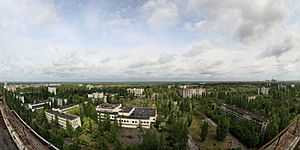Nuclear fallout facts for kids

Fallout is the dangerous radiation that remains after a nuclear explosion. The name comes from the fact that tiny radioactive bits "fall out" of the air after being spread by the blast. These materials keep giving off radiation for minutes, days, or even hundreds of years. "Fallout" often refers to the radioactive dust made when a nuclear weapon explodes. All nuclear explosions create radioactive atoms called fission products. Also, tiny particles called neutrons from the explosion can make nearby materials radioactive.
There was also radioactive fallout after a part of the nuclear power station at Chernobyl exploded. This fallout caused serious contamination over a large area. This included parts of Ukraine, Belarus, Russia, Scandinavia, and some parts of Europe. Everyone living within 30 kilometers (about 18.6 miles) of the power plant had to move because of the fallout. Many villages and towns were left empty.
Contents
What is Fallout?
Fallout is basically the radioactive dust and particles that spread after a nuclear blast. When a nuclear weapon explodes, it breaks apart atoms. This process creates new, unstable atoms called "fission products." These new atoms are radioactive, meaning they give off energy in the form of radiation.
How Fallout Spreads
When a nuclear bomb explodes, it sends a huge cloud of dust and debris high into the sky. This cloud contains the radioactive fission products. Winds then carry this cloud far away. Eventually, these radioactive particles fall back to Earth, like dust or rain. This is why it's called "fallout."
The danger from fallout comes from the radiation these particles release. This radiation can be harmful to living things. The amount of danger depends on how much radiation is present and how long someone is exposed to it.
The Chernobyl Disaster
One of the most famous examples of fallout happened after the Chernobyl disaster in 1986. This was not a nuclear weapon, but a nuclear power plant that exploded. The explosion released a huge amount of radioactive material into the air.
Impact of Chernobyl Fallout
The fallout from Chernobyl spread over a very large area. It affected parts of Ukraine, Belarus, and Russia the most. But winds carried some radioactive particles across Europe. People living close to the plant had to leave their homes forever. An area of 30 kilometers (about 18.6 miles) around the plant became an "Exclusion Zone." No one is allowed to live there permanently because of the high levels of radiation.
The Chernobyl disaster showed how dangerous fallout can be. It caused health problems for many people and made large areas unsafe for a long time. Even today, some areas are still affected by the radiation.
Images for kids
-
A sign for a Fallout shelter on a building in New York City. These shelters were built to protect people from fallout.
See also
 In Spanish: Lluvia radiactiva para niños
In Spanish: Lluvia radiactiva para niños







